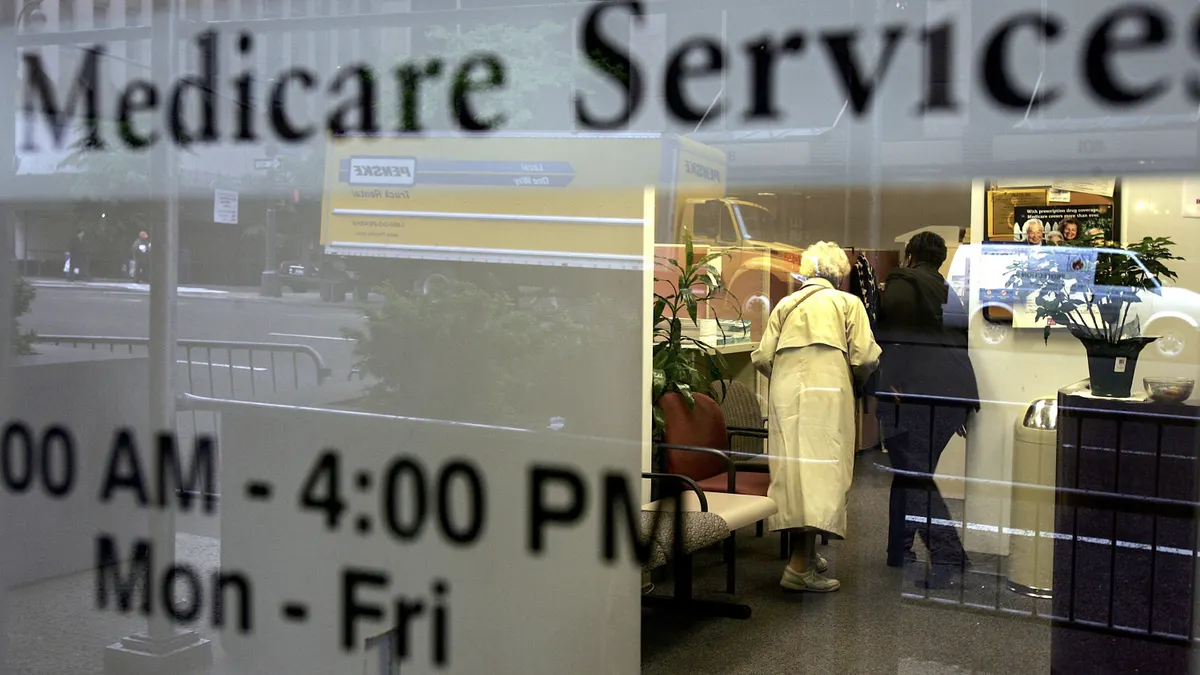Dive Brief:
- The CMS has released complete data about the Medicare Advantage plan landscape for 2026, showing how the three largest carriers are paring back their coverage to focus on profits.
- UnitedHealthcare, Humana and Aetna all reduced the number of states and counties they serve for 2026, following through on promises to trim underperforming geographies to try to recover flagging margins.
- The cutback on the part of large national payers creates a growth opportunity for small and regional carriers to snap up members next year, but is also likely to cause turmoil for seniors in the privatized Medicare plans, many of which are unaware that they may face significant changes to their costs and benefits.
Dive Insight:
Overall, MA plans available to seniors stayed relatively stable for 2026, with a reduction in general enrollment MA plans offset by an increase in special needs plans next year.
A senior in an average American county will be able to choose between 41.9 MA plans next year, compared to 42.8 in 2025, with the majority available with zero monthly premium, according to an analysis of CMS data by healthcare consultancy ATI Advisory.
But the appearance of stability belies significant movement under the surface as major carriers pare back their service areas and take other steps to bolster flagging margins in the privatized Medicare program. MA profits have shrunk over the past two years as seniors utilized more and pricier medical care than expected and policy changes from Washington pressured reimbursement.
In 2026, UnitedHealthcare, the insurance division of healthcare behemoth UnitedHealth, is offering plans in one fewer state and 109 fewer counties, according to the company. Humana is offering plans in three fewer states and 194 fewer counties. Aetna, the insurance division of retail health giant CVS, is offering plans in one fewer state and 100 fewer counties.
Elevance and Centene — the fourth-largest and sixth-largest MA carrier, respectively — are bucking the trend and increasing their footprints for 2026, albeit modestly. Elevance is adding one state and 64 counties, though the insurer elected to exit the Part D prescription drug market entirely. Centene kept its state footprint stable but did add 51 counties for 2026.
Meanwhile Kaiser, the fifth-largest MA carrier, made no changes to its service areas, though the payer did close certain plans in the mid-Atlantic region and in Washington, according to a spokesperson.
The three biggest MA carriers are retrenching their offerings for next year
Shifting offerings from these six companies create outsized turmoil for the market. Taken together, UnitedHealthcare, Humana, Aetna, Elevance, Kaiser and Centene covered about 25.2 million seniors — almost three-fourths of the entire MA population — as of September.
On top of this, some smaller payers struggling with rising cost of health care are also exiting the MA market, including UCare of Minnesota and Samaritan Health Plans of Oregon. As a result, hundreds of thousands of MA customers, if not upwards of one million, could end up shopping for new plans during this fall’s open enrollment.
And it’s already difficult for seniors to digest changes to their coverage. Many seniors find shopping for plans confusing, or plan to reenroll in coverage without reviewing their Medicare plan options, according to a recent survey from insurance marketplace eHealth. As such, many MA enrollees could end up in coverage for 2026 without realizing it may be less generous than it appears.
That’s especially as insurers are also pulling enrollment strings and tweaking their plans in a way that might fly under the radar for consumers not versed in health literacy.
Though the CMS projects that the average monthly premium across MA plans will drop from $16.40 this year to $14 in 2026, that analysis includes group MA and special needs plans. For the general enrollment MA population, which accounts for the brunt of the program, average monthly premiums weighted by enrollment are actually increasing by $2.84, or almost 22%, compared to 2025, according to an analysis of CMS data by Morgan Stanley.
Large insurers are also saddling consumers with higher costs through less obvious means, including by raising deductibles and out-of-pocket maximums, according to analysts.
Meanwhile, carriers are trimming certain benefits. For example, Aetna, Elevance and UnitedHealthcare materially cut allowances to cover certain over-the-counter health and wellness items for non-special needs plans, while UnitedHealthcare and Humana cut the OTC benefits for special needs plans too, according to a research note from investment bank TD Cowen.
Major payers are also prioritizing plan designs like HMOs, or health maintenance organizations, which have more limited provider networks, giving members fewer options for doctors — but insurers greater control over medical costs.
Insurers, including UnitedHealthcare, have also been shifting commissions to brokers to incentivize enrollment in more profitable plans.
Still, major payers touted their offerings in press releases on Wednesday, when the CMS released complete MA plan information for next year.
“Our 2026 offerings preserve access to affordable Medicare Advantage plans despite programmatic funding cuts,” UnitedHealthcare said in a release.
Despite the turbulence, the Trump administration projects that overall MA enrollment will remain “more robust” than plans expect, dropping to 34 million from almost 35 million this year. Still, that would mean MA no longer covers more than half of all Medicare enrollees — and would mark the first year-over-year decrease in enrollment in roughly two decades.
Medicare open enrollment runs from Oct. 15 through Dec. 7.
Editor’s note: This story has been updated with additional service area data from MA insurers.















